- James, Thomas. The voyages and distresses of Captain T. James, and Mr. H. Ellis, for the discovery of a North-west Passage to the South Seas. London : Printed by T. Maiden for Ann Lemoine and J. Roe, 1807. (title page) [Stefansson G650 1631 .J2]
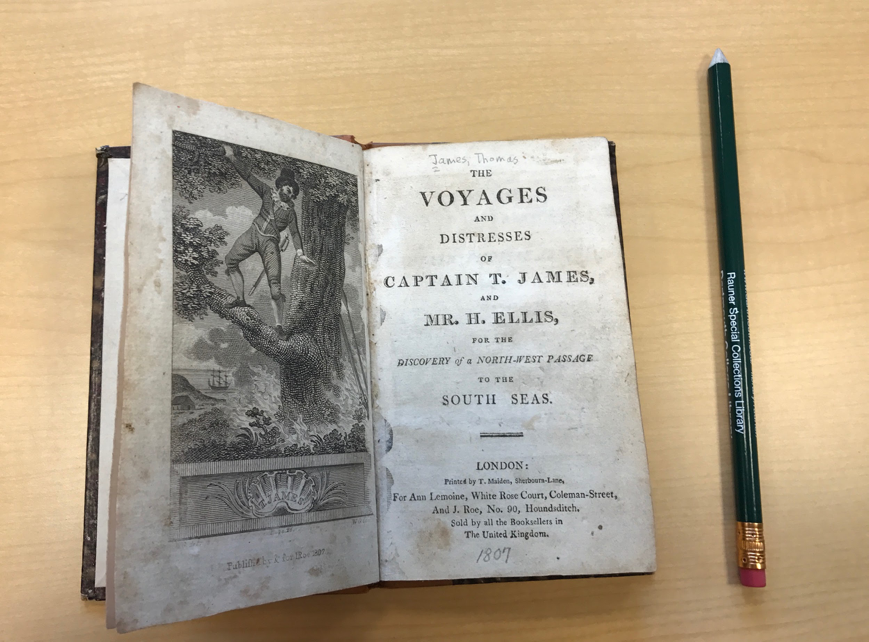 Published in 1633 this book recounts the journey of Captain James on his 1631 expedition in search of the Northwest Passage. This item represents one of the earlier expeditions and one of many failed attempts in pursuit of the Northwest Passage. Yet without these early trips, much of the area would be uncharted and even more unknown. On his expedition, Captain James sailed through the Hudson Strait and into James Bay where the ship spent the winter. After surviving the brutal arctic winter their ship, the Henrietta Maria, was barely able to make the return journey. As with all arctic explorations Captain James witnessed many hardships but returned to share his story.
Published in 1633 this book recounts the journey of Captain James on his 1631 expedition in search of the Northwest Passage. This item represents one of the earlier expeditions and one of many failed attempts in pursuit of the Northwest Passage. Yet without these early trips, much of the area would be uncharted and even more unknown. On his expedition, Captain James sailed through the Hudson Strait and into James Bay where the ship spent the winter. After surviving the brutal arctic winter their ship, the Henrietta Maria, was barely able to make the return journey. As with all arctic explorations Captain James witnessed many hardships but returned to share his story.
- Fisher, Alexander. Journal of a voyage of discovery, to the Arctic regions: performed between the 4th of April and the 18th of November, 1818, in His Majesty’s ship Alexander, Wm. Edw. Parry … Commander / by an officer of the Alexander. London : Printed for Richard Phillips by G. Sidney, [1820?] (title page with foldout map) [Stefansson G650 1818 .F5]
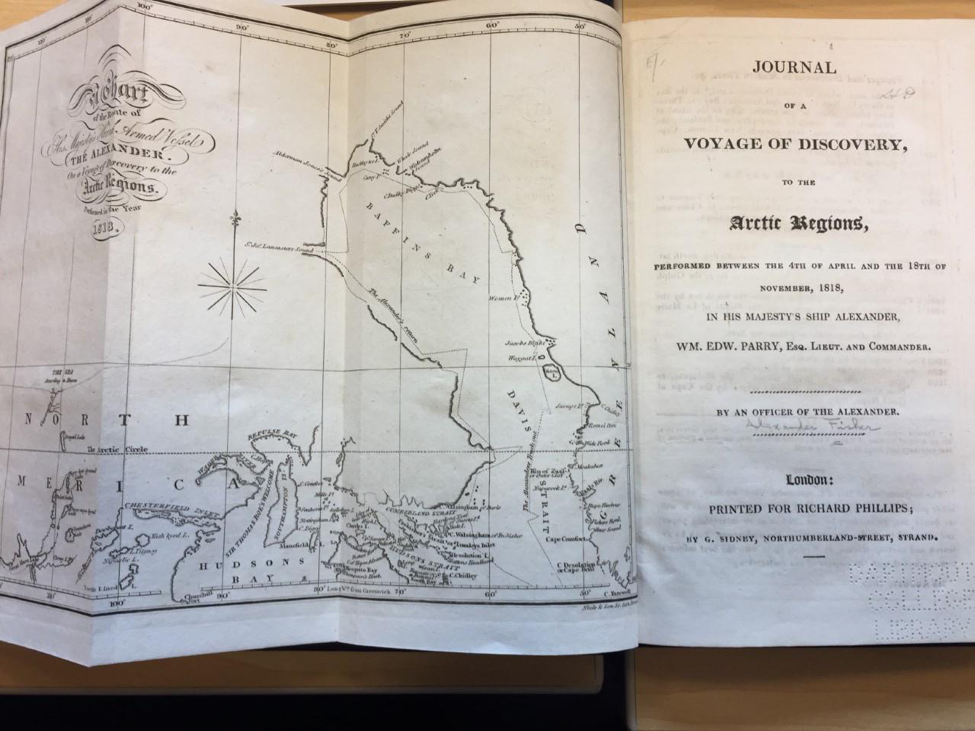 This journal is from 1818 and describes the voyage of William Parry’s explorations of the Arctic regions. In the book, he describes what he does on a daily basis, different encounters with weather patterns and what he sees, and why he makes the decisions that he does. It gives an inside look to what life was like on these explorations. The reason for the exploration was an attempt to find the Northwest Passage that would link the Atlantic to the Pacific through the Bering Strait. This journal also contains information as to why these men went on such voyages, not just for trade but also for their country’s pride.
This journal is from 1818 and describes the voyage of William Parry’s explorations of the Arctic regions. In the book, he describes what he does on a daily basis, different encounters with weather patterns and what he sees, and why he makes the decisions that he does. It gives an inside look to what life was like on these explorations. The reason for the exploration was an attempt to find the Northwest Passage that would link the Atlantic to the Pacific through the Bering Strait. This journal also contains information as to why these men went on such voyages, not just for trade but also for their country’s pride.
- Letters written during the late voyage of discovery in the Western Arctic Sea / by an officer of the expedition. London : Printed for Sir Richard Phillips, 1821. (pgs. 47, 51) [Stefansson G650 1819 .P2]
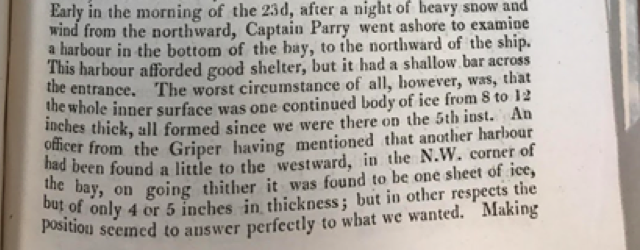
 As a compilation of letters written by crew members during Captain William Parry’s 1819 voyage, this anthology sheds new insight on the voyage and what it was really like. It not only provides supplementary observations that corroborate Parry’s own, but it adds in previously excluded information to create a more complete picture about what the voyage was truly like. The letters describe everything from daily ship-life to the peculiar flora, fauna, and geographic landmarks that the crew members came across on their journey. However, it is important to note that these excerpts only represent a small portion of what these letters have to offer. William Parry and his voyages were not only one of the most successful, but some of the most informative. As one of Franklin’s top competitors, Parry’s voyages motivated and influenced the path Franklin eventually chose to take – significantly shaping England’s understanding of the Arctic and their future endeavors in it.
As a compilation of letters written by crew members during Captain William Parry’s 1819 voyage, this anthology sheds new insight on the voyage and what it was really like. It not only provides supplementary observations that corroborate Parry’s own, but it adds in previously excluded information to create a more complete picture about what the voyage was truly like. The letters describe everything from daily ship-life to the peculiar flora, fauna, and geographic landmarks that the crew members came across on their journey. However, it is important to note that these excerpts only represent a small portion of what these letters have to offer. William Parry and his voyages were not only one of the most successful, but some of the most informative. As one of Franklin’s top competitors, Parry’s voyages motivated and influenced the path Franklin eventually chose to take – significantly shaping England’s understanding of the Arctic and their future endeavors in it.
- Narrative of a voyage by Captain Ross, in the years 1829, 30, 31,32, and 33, to discover a north-west passage from the Eastern to the Western Ocean … the loss of the Victory steam ship, the discovery of the North pole, and the happy rescue of Captain Ross and his crew by the Isabella, a whale ship from Hull, by which they safely returned to their native country. London : William Mason, 1835. (book cover) [Stefansson G650 1829 .R85]
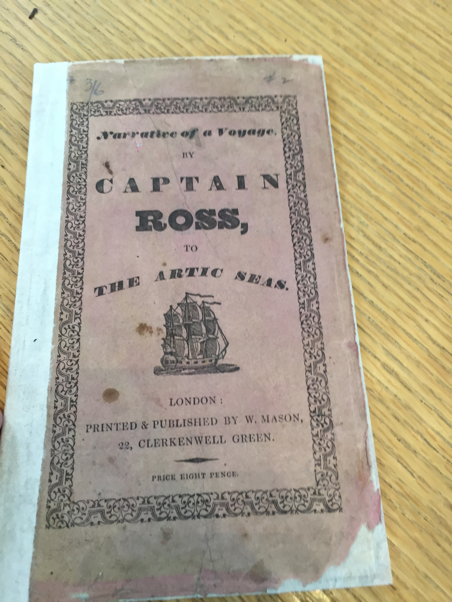 This short pamphlet recounts the journey of Captain Ross and his crew in search of the Northwest Passage, which took place from 1829-1832. It tells this story using both a narrative voice, as well as Ross’s own words in a letter to Admiralty of England. At a noted price of eight pence and given the dramatic writing style, it appears to be an item that might have been sold at some sort of newsstand. The narrative itself focuses on the support Ross received from private benefactor Felix Booth and the guidance from other contemporary explorers like Parry and Franklin as he and his crew attempted to discover a sea route through the Northwest Passage. While they were unable to locate a feasible route, Ross did succeed in becoming the first explorer to reach the magnetic North Pole, for which he was commended following his fortuitous rescue and gallant return to England.
This short pamphlet recounts the journey of Captain Ross and his crew in search of the Northwest Passage, which took place from 1829-1832. It tells this story using both a narrative voice, as well as Ross’s own words in a letter to Admiralty of England. At a noted price of eight pence and given the dramatic writing style, it appears to be an item that might have been sold at some sort of newsstand. The narrative itself focuses on the support Ross received from private benefactor Felix Booth and the guidance from other contemporary explorers like Parry and Franklin as he and his crew attempted to discover a sea route through the Northwest Passage. While they were unable to locate a feasible route, Ross did succeed in becoming the first explorer to reach the magnetic North Pole, for which he was commended following his fortuitous rescue and gallant return to England.
- Burford, Robert. Description of a view of the continent of Boothia, discovered by Captain Ross, in his late expedition to the polar regions, now exhibiting at the Panorama, Leicester square. London: J. & G. Nichols, 1843. (title page, panorama) [Stefansson G650 1830 .B87]
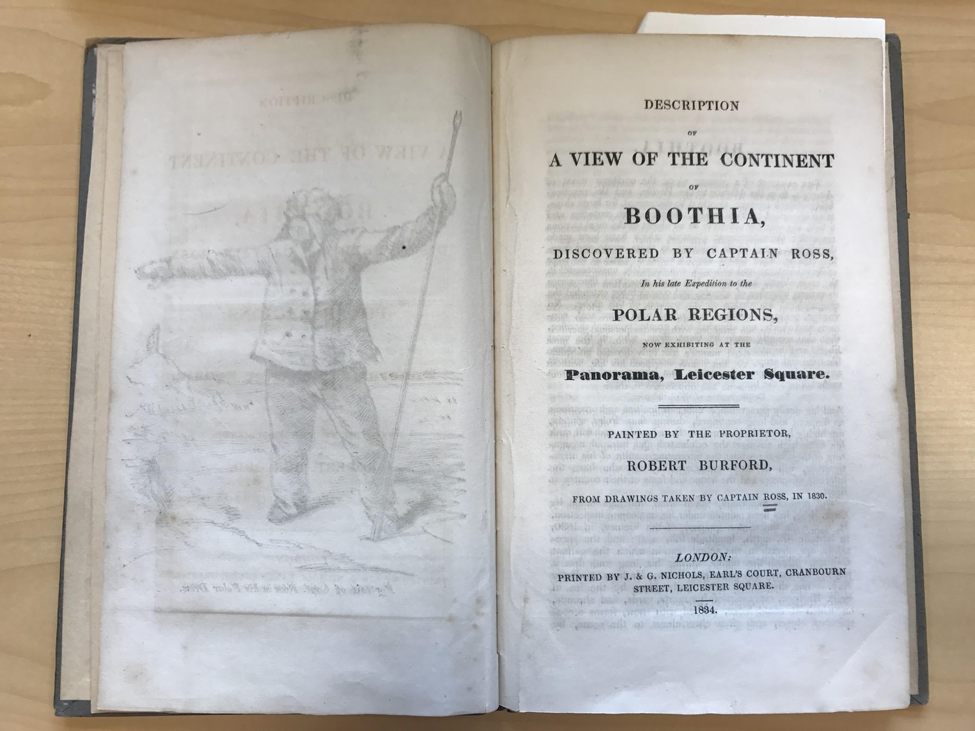
 Captain John Ross’s career was among the most successful the nineteenth-century British Arctic explorers, as he became the first European man in the Gulf of Boothia and to discover the magnetic North Pole. Ross’ discovery was significant in that the British Navy was very interested in magnetism and navigation at the time. This source gives the account of his expedition to determine the probability of a waterway that connects the Atlantic and Pacific oceans. The voyage considerably strengthened the hopes of a passage being found, and locating the true position of the magnetic North Pole allowed for easier navigation for later Arctic expeditions.
Captain John Ross’s career was among the most successful the nineteenth-century British Arctic explorers, as he became the first European man in the Gulf of Boothia and to discover the magnetic North Pole. Ross’ discovery was significant in that the British Navy was very interested in magnetism and navigation at the time. This source gives the account of his expedition to determine the probability of a waterway that connects the Atlantic and Pacific oceans. The voyage considerably strengthened the hopes of a passage being found, and locating the true position of the magnetic North Pole allowed for easier navigation for later Arctic expeditions.
This source describes Captain Ross’s second arctic expedition after William Parry had discovered the main axis of the Northwest Passage in 1819. After passing through Baffin Bay, Ross and his team reached Fury Beach (where Parry had abandoned his ship) and then continued south into the Gulf of Boothia; Ross was the first European to reach this Gulf. The panorama image pictured here is an illustration of Ross’s winter quarters at Felix Harbor at the eastern tip of the Boothia Peninsula where Ross and his team were blocked in by ice 200 miles south of Fury Beach. For the next four winters, Ross and his team made several trips into the interior attempting to find passages out. By the fourth winter he and his team left their boats and walked towards Batty Bay where they saw open water for the first time. By August 1833 the team was rescued by the Isabella.
- Lyon, G. F. (George Francis). A brief narrative of an unsuccessful attempt to reach Repulse Bay, through Sir Thomas Rowe’s “Welcome,” in His Majesty’s ship Griper, in the year MDCCCXXIV. London : John Murray, 1825. (foldout map) [Stefansson G650 1824 .L9]
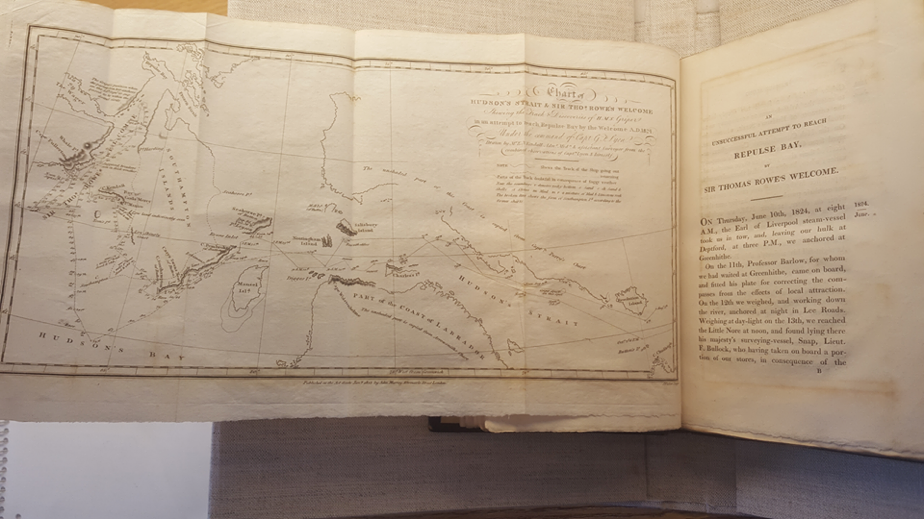 This account, written by Captain G.F Lyon, recounts his mission to sail into arctic waters. Although the expedition failed to reach Repulse Bay, they ultimately succeeded in returning to England alive. This narrative provides a further account of the difficulties inherent to arctic travel and can help us to conceptualize the dangers Franklin’s expedition may have encountered. It also provides detailed descriptions about encounters with native people, struggles to find water without ice, and severe storms. Using the map included within the narrative, we can see a depiction of the route Captain Lyon took and also gain a sense of what information, or lack of information, explorers were working with when they set sail into the Arctic.
This account, written by Captain G.F Lyon, recounts his mission to sail into arctic waters. Although the expedition failed to reach Repulse Bay, they ultimately succeeded in returning to England alive. This narrative provides a further account of the difficulties inherent to arctic travel and can help us to conceptualize the dangers Franklin’s expedition may have encountered. It also provides detailed descriptions about encounters with native people, struggles to find water without ice, and severe storms. Using the map included within the narrative, we can see a depiction of the route Captain Lyon took and also gain a sense of what information, or lack of information, explorers were working with when they set sail into the Arctic.
- Voyages in the Arctic seas, from 1821 to 1825, for the discovery of a north-west passage to the Pacific Ocean. Dublin, Printed by R. Napper, 1830. (title page, pgs. 156-157) [Stefansson G170 .V97]
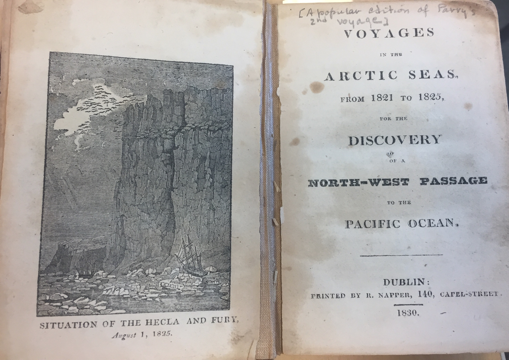
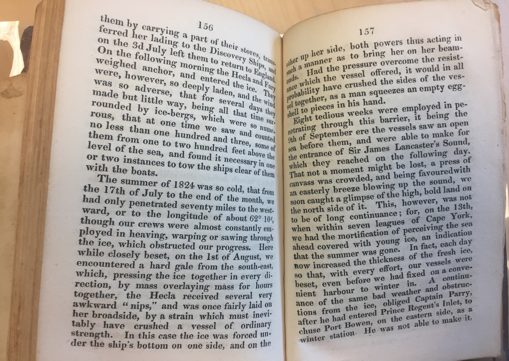 This book narrates Captain William Parry’s second voyage that took place from 1821 to 1825. As a sequel to the book titled Arctic Voyages, the account primarily focuses on Captain Parry’s experience with Captain George Francis Lyon aboard the ships, the Hecla and the Fury. Throughout the book, Parry illustrates the hardships the explorers faced, notably in regards to weather conditions and thick ice. Parry’s description of the voyage as being “surrounded by ice-bergs” that were “one to two hundred feet above the level of the sea” showcases the struggle of finding a route to the Northwest Passage. Due to the unbearably cold summer of 1824 that resulted in extremely treacherous ice, Parry’s ships were forced to turn for home. However, despite the failure to find a passage, the expedition inspired a motivation and drive to continue searching for the Northwest Passage.
This book narrates Captain William Parry’s second voyage that took place from 1821 to 1825. As a sequel to the book titled Arctic Voyages, the account primarily focuses on Captain Parry’s experience with Captain George Francis Lyon aboard the ships, the Hecla and the Fury. Throughout the book, Parry illustrates the hardships the explorers faced, notably in regards to weather conditions and thick ice. Parry’s description of the voyage as being “surrounded by ice-bergs” that were “one to two hundred feet above the level of the sea” showcases the struggle of finding a route to the Northwest Passage. Due to the unbearably cold summer of 1824 that resulted in extremely treacherous ice, Parry’s ships were forced to turn for home. However, despite the failure to find a passage, the expedition inspired a motivation and drive to continue searching for the Northwest Passage.